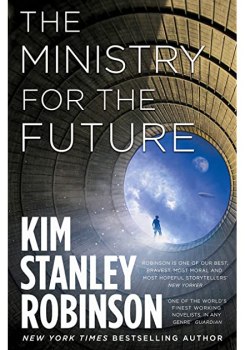‘The Ministry for the Future’ Imagines A Dark But Hopeful Future
In a novel described as optimistic and alarming, Kim Stanley Robinson writes for our endangered—but not ultimately doomed—world.
The following is an excerpt from The Ministry for the Future by Kim Stanley Robinson.
Disclaimer: When you purchase products through the Bookshop.org link on this page, Science Friday may earn a small commission which helps support our journalism.

The Ministry for the Future
Article 14 of the Paris Agreement Under the United Nations Framework Convention on Climate Change called for a periodic taking stock of all the signatory nations’ carbon emissions, which meant in effect the total global carbon burn for the year in question. The first “global stocktake” was scheduled for 2023, and then every five years after that.
That first global stocktake didn’t go well. Reporting was inconsistent and incomplete, and yet still it was very clear that carbon emissions were far higher than the Parties to the Agreement had promised each other they would be, despite the 2020 dip. Very few nations had hit the targets they had set for themselves, even though they had set soft targets. Aware of the shortfall even before the 2023 stocktake, 108 countries had promised to strengthen their pledges; but these were smaller countries, amounting together to about 15 percent of global total emissions.
So at the annual Conference of the Parties the following year, some delegations pointed out that the Agreement’s Article 16, clause 4, specified that the COP “shall make the decisions necessary to promote the Agreement’s effective implementation by establishing such subsidiary bodies as are deemed necessary for the implementation of the Agreement.” They also pointed to Article 18, clause 1, which allowed the COP to create new “Subsidiary Bodies for Implementation of the Agreement.” These subsidiary bodies had previously been understood to mean committees that met only during the annual COP gatherings, but now some delegates argued that given the general failure of the Agreement so far, a new subsidiary body with permanent duties, and the resources to pursue them, was clearly needed to help push the process forward.
So at COP29, held in Bogotá, Colombia, the Parties to the Agreement created a new Subsidiary Body for Implementation of the Agreement, as authorized by Articles 16 and 18, to be funded using the funding protocols outlined in Article 8, which bound all Parties to the methods outlined in the Warsaw International Mechanism for Loss and Damage. The announcement said:
“Be it resolved that a Subsidiary Body authorized by this twenty-ninth Conference of the Parties serving as the meeting of the parties to the Paris Climate Agreement (CMA) is hereby established, to work with the Intergovernmental Panel on Climate Change, and all the agencies of the United Nations, and all the governments signatory to the Paris Agreement, to advocate for the world’s future generations of citizens, whose rights, as defined in the Universal Declaration of Human Rights, are as valid as our own. This new Subsidiary Body is furthermore charged with defending all living creatures present and future who cannot speak for themselves, by promoting their legal standing and physical protection.”
Someone in the press named this new agency “the Ministry for the Future,” and the name stuck and spread, and became what the new agency was usually called. It was established in Zurich, Switzerland, in January of 2025.
Not long after that, the big heat wave struck India.
Excerpted from The Ministry for the Future © 2020 Kim Stanley Robinson. Reproduced with permission of Hachette Book Group.
Kim Stanley Robinson is a New York Times bestseller and winner of the Hugo, Nebula, and Locus awards. He is the author of more than 20 books, including New York 2140 and The Ministry for the Future. He lives in Davis, California.